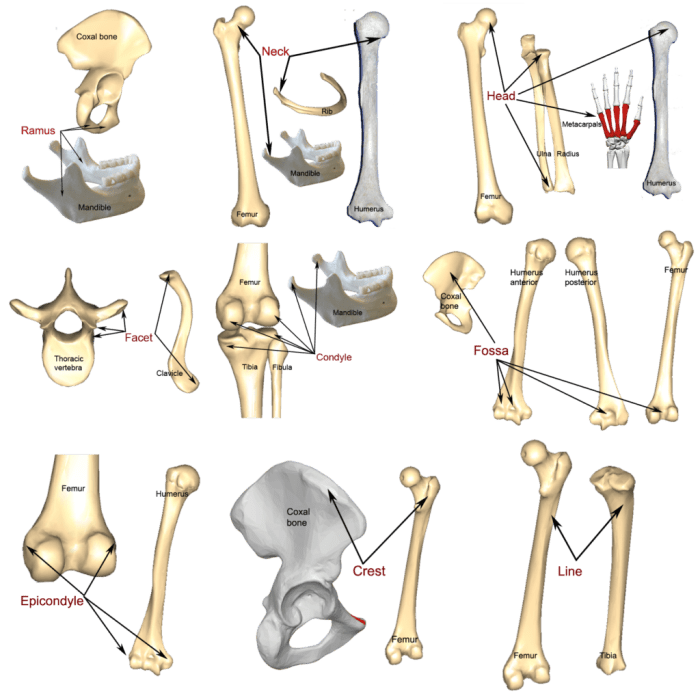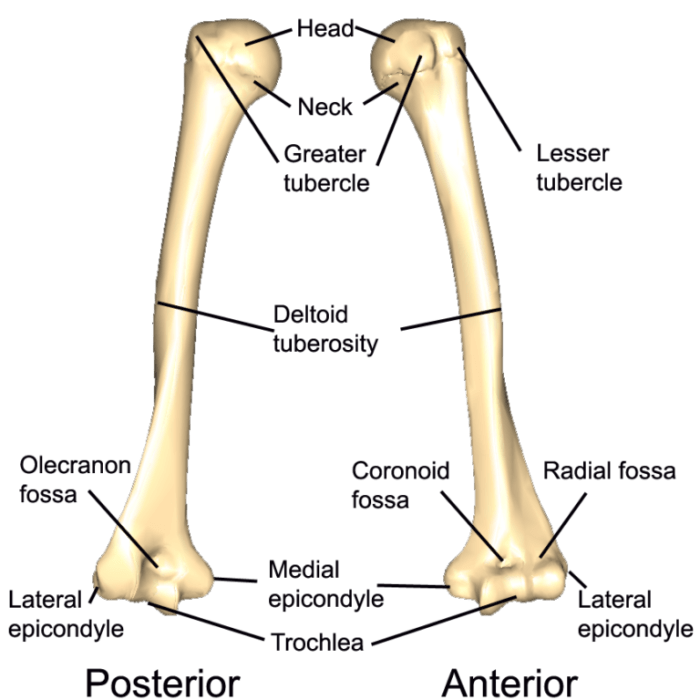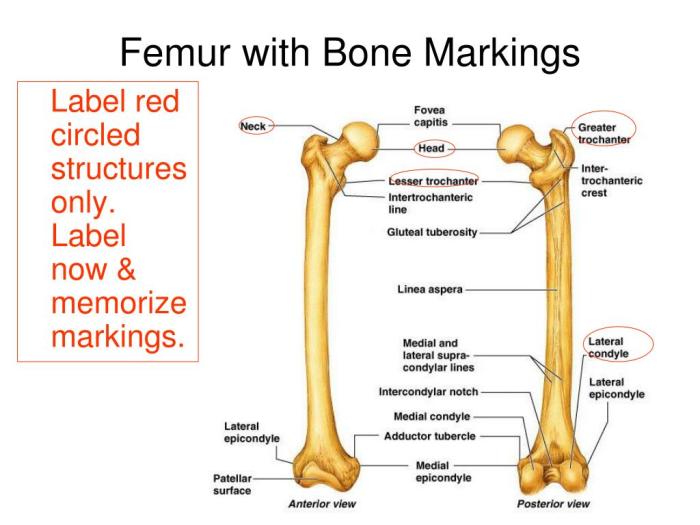Embark on a captivating journey with our bone and bone markings quiz, where you’ll unravel the intricate world of skeletal anatomy. Prepare to be enlightened as we delve into the structure, composition, and fascinating markings that adorn our bones.
Join us as we explore the diverse types of bones, their unique functions, and the intriguing process of bone formation and growth. Along the way, we’ll shed light on common bone diseases and disorders, empowering you with knowledge to navigate the complexities of skeletal health.
Bone Anatomy

Bones are the hard, mineralized tissue that makes up the skeletal system. They provide support and protection for the body, and they also play a role in movement, blood cell production, and mineral storage.
Bone Structure and Composition
Bones are composed of a hard outer layer of compact bone and a spongy inner layer of trabecular bone. The compact bone is made up of tightly packed osteons, which are cylindrical structures that contain blood vessels and nerves. The trabecular bone is made up of a network of thin, bony struts.
Bones are composed of a variety of minerals, including calcium, phosphorus, and magnesium. These minerals give bones their hardness and strength. Bones also contain a protein called collagen, which provides flexibility.
Diagram of a Long Bone
Long bones are the most common type of bone in the body. They are found in the arms, legs, and fingers.
Just like navigating the complexities of a bone and bone markings quiz, understanding the intricacies of electrical conduit installations can be equally challenging. In the world of electrical work, back-to-back bends conduit techniques offer a unique solution to routing wires efficiently and effectively.
Returning to our quiz, mastering bone and bone markings knowledge empowers us to unravel the mysteries of the human skeletal system.

The diagram shows the different parts of a long bone.
- Diaphysis:The shaft of the bone.
- Epiphysis:The ends of the bone.
- Metaphysis:The region between the diaphysis and epiphysis.
- Articular cartilage:The cartilage that covers the ends of the bone.
- Periosteum:The membrane that covers the outer surface of the bone.
- Endosteum:The membrane that lines the inner surface of the bone.
- Medullary cavity:The cavity in the center of the bone that contains bone marrow.
Types of Bone Cells
There are three main types of bone cells:
- Osteoblasts:These cells build new bone.
- Osteocytes:These cells maintain bone.
- Osteoclasts:These cells break down bone.
Bone cells work together to maintain the health and strength of bones.
Bone Markings
Bone markings are anatomical features found on the surface of bones. These markings serve various purposes, including providing attachment points for muscles, tendons, and ligaments, facilitating joint movement, and protecting delicate structures within the bone.
Common Bone Markings
| Bone Marking | Description |
|---|---|
| Articular Facet | A smooth, flat surface that allows bones to articulate with each other. |
| Condyle | A rounded knob-like projection that fits into an articular cavity. |
| Crest | A narrow, elevated ridge that provides attachment for muscles or ligaments. |
| Foramen | A hole or opening that allows nerves, blood vessels, or other structures to pass through. |
| Groove | A narrow, linear depression that accommodates tendons, nerves, or blood vessels. |
| Process | A bony projection that extends from the main body of the bone, serving as an attachment site or providing additional support. |
| Tubercle | A small, rounded projection that serves as an attachment site for muscles or ligaments. |
Examples of Bones with Specific Bone Markings, Bone and bone markings quiz
- The femur (thigh bone) has a large articular facet called the femoral head, which fits into the acetabulum of the pelvis.
- The humerus (upper arm bone) has a condyle at its distal end, which articulates with the radius and ulna.
- The tibia (shin bone) has a crest called the tibial crest, which provides attachment for the patellar ligament.
- The skull has numerous foramina, including the foramen magnum, which allows the spinal cord to pass through.
- The ribs have grooves called costal grooves, which accommodate intercostal nerves and blood vessels.
- The vertebrae have spinous processes, which provide attachment for muscles and ligaments that support the spine.
- The scapula (shoulder blade) has a tubercle called the acromion, which serves as an attachment site for the deltoid muscle.
Types of Bones

Bones, the building blocks of our skeletal system, vary in shape and function. Understanding these variations is crucial for comprehending bone anatomy and physiology.
Bones can be broadly classified into four main types based on their shape and function: long bones, short bones, flat bones, and irregular bones. Each type possesses unique characteristics that contribute to its specific role in the body.
Long Bones
Long bones, as the name suggests, are characterized by their elongated shape. They are typically found in the limbs, such as the femur in the thigh or the humerus in the upper arm. Long bones primarily serve the functions of support, movement, and protection.
- Support: Long bones provide structural support to the body, allowing it to bear weight and maintain an upright posture.
- Movement: The muscles attached to long bones enable a wide range of movements, from walking and running to grasping and lifting objects.
- Protection: Long bones shield delicate internal structures, such as the brain and spinal cord, from external forces.
Short Bones
Short bones are cube-shaped or slightly elongated, resembling small blocks. They are commonly found in the wrists and ankles, where they provide stability and flexibility to these joints.
- Stability: Short bones contribute to the overall stability of the wrist and ankle joints, preventing excessive movement and potential dislocations.
- Flexibility: Despite their stability, short bones allow for a certain degree of movement, enabling the wrists and ankles to perform complex and precise actions.
Flat Bones
Flat bones are thin, plate-like structures that serve primarily as protective barriers and attachment sites for muscles. They are found in various parts of the body, including the skull, ribs, and pelvis.
- Protection: Flat bones shield vital organs, such as the brain, heart, and lungs, from external impacts and injuries.
- Muscle Attachment: The broad surfaces of flat bones provide ample attachment points for muscles, enabling efficient muscle action and movement.
Irregular Bones
Irregular bones, as the name implies, have complex shapes that do not fit into the other categories. They are found in various locations throughout the body, including the vertebrae, facial bones, and some bones of the skull.
- Unique Shapes: Irregular bones exhibit a wide range of shapes and sizes, reflecting their specialized functions and the unique anatomical regions they occupy.
- Protection and Support: Irregular bones often provide protection to underlying structures and contribute to the overall support of the body.
Bone Development and Growth

Bone development and growth is a complex process that begins in the womb and continues throughout childhood and adolescence. It involves the formation of new bone tissue, the growth of existing bone, and the remodeling of bone to meet the changing needs of the body.
Bone formation begins with the formation of a cartilage model of the bone. This cartilage model is then gradually replaced by bone tissue through a process called ossification. Ossification begins in the center of the bone and progresses outward toward the ends.
As the bone grows, new bone tissue is added to the ends of the bone, and the bone becomes thicker and longer.
Role of Hormones and Nutrients in Bone Development
Several hormones and nutrients play a vital role in bone development and growth. These include:
- Growth hormone:Growth hormone is produced by the pituitary gland and is essential for bone growth. It stimulates the production of new bone cells and the growth of existing bone cells.
- Parathyroid hormone:Parathyroid hormone is produced by the parathyroid glands and helps to regulate calcium levels in the blood. It stimulates the release of calcium from bone into the blood, which is necessary for bone growth.
- Vitamin D:Vitamin D is essential for the absorption of calcium from the diet. It is produced by the skin when exposed to sunlight, and it can also be obtained from foods such as fatty fish, eggs, and fortified milk.
- Calcium:Calcium is the main mineral component of bone. It is essential for the formation of new bone tissue and the maintenance of bone strength.
Factors that Can Affect Bone Growth and Development
Several factors can affect bone growth and development, including:
- Genetics:Genetics play a role in determining the size and shape of bones. Some people are naturally taller or shorter than others, and this is largely due to genetic factors.
- Nutrition:A healthy diet is essential for bone growth and development. Children who do not get enough calcium, vitamin D, and other essential nutrients may have stunted bone growth and weak bones.
- Exercise:Exercise can help to strengthen bones and promote bone growth. Children who are active and play sports are more likely to have strong bones than those who are inactive.
- Medical conditions:Certain medical conditions can affect bone growth and development. These include conditions such as growth hormone deficiency, parathyroid disorders, and bone diseases.
Bone Diseases and Disorders

Bone diseases and disorders can significantly impact overall health and well-being. Understanding these conditions, their symptoms, causes, and treatments is crucial for maintaining bone health and preventing complications.
Osteoporosis
Osteoporosis is a common bone disease that causes bones to become weak and brittle, increasing the risk of fractures. It primarily affects postmenopausal women and older adults. Symptoms may include back pain, loss of height, and increased bone fragility. Treatment involves lifestyle modifications, such as regular exercise and a balanced diet, along with medications to increase bone density.
Osteoarthritis
Osteoarthritis is a degenerative joint disease that causes the breakdown of cartilage in the joints. It typically affects weight-bearing joints, such as the knees, hips, and spine. Symptoms include joint pain, stiffness, swelling, and reduced range of motion. Treatment focuses on pain management, physical therapy, and, in severe cases, joint replacement surgery.
Paget’s Disease of Bone
Paget’s disease of bone is a chronic disorder that affects the normal remodeling process of bones. It can cause bones to become enlarged, weakened, and deformed. Symptoms may include bone pain, fractures, and hearing loss. Treatment involves medications to slow down bone turnover and reduce pain.
Bone Cancer
Bone cancer is a rare but serious condition that occurs when malignant cells form in the bones. Symptoms vary depending on the location and type of cancer, but may include pain, swelling, weakness, and fatigue. Treatment options include surgery, chemotherapy, radiation therapy, and targeted therapies.
Impact of Bone Diseases on Overall Health
Bone diseases and disorders can have significant consequences for overall health. They can lead to chronic pain, mobility limitations, and an increased risk of falls and fractures. Additionally, some bone diseases, such as osteoporosis, can increase the risk of other health problems, such as heart disease and stroke.
Early diagnosis and treatment are essential for managing bone diseases and minimizing their impact on health and well-being.
FAQ Overview: Bone And Bone Markings Quiz
What is the primary function of bone markings?
Bone markings serve as attachment points for muscles, tendons, and ligaments, providing stability and facilitating movement.
How many types of bone cells are there?
There are three main types of bone cells: osteoblasts, osteocytes, and osteoclasts, each playing a distinct role in bone formation, maintenance, and resorption.
What is the difference between a long bone and a flat bone?
Long bones, such as the femur, are characterized by their elongated shape and provide structural support and movement, while flat bones, like the skull, are thin and broad, offering protection and serving as attachment points for muscles.